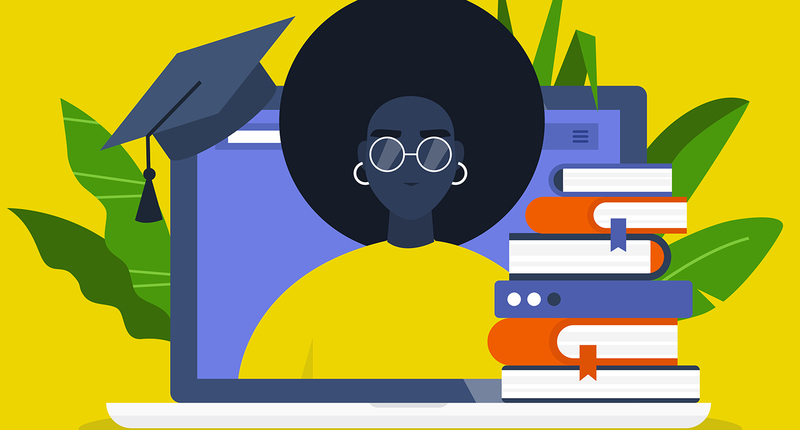Every month we will be updating our new digital library with new articles covering the hottest topics in education and graduate education including remote teaching, student support, anti-racist education, graduate student and postdoc support, and more.
September 2020 News
Are You Working? How to Move Past Fear and Into Productivity
Question: How do you write when you’re scared of your dissertation? I can’t even open a document for days. I think a portion of it is a fear of impending criticism from my committee — the result of both a longstanding aversion to criticism and a more recent set of criticisms I got in the prospectus phase of my project. Another portion is perhaps having a “scary adviser” who, in fact, has never been scary in our meetings and has been very encouraging. The scariness, I think, comes from this person’s reputation in the field and my fear that I might turn in something that disappoints. And then probably the third element of the scariness — that I can identify — is that this is my very own, Very Big Project (if that makes sense).
Signed, Scared
Oh, it makes so very much sense. You have articulated the innermost thoughts of every graduate student: “What if everyone finds out I don’t really know as much as they think I do? What if, at my dissertation defense, they pull a Billy Madison on me, and award zero points?”

,
Leading the Way in Learner-Led Design | UCLA Library
The UCLA Library and the Center for Education Innovation & Learning in the Sciences (CEILS) are partnering to help undergraduates excel in the STEM disciplines by focusing on “learner-led” design —teaching sessions and materials created for students, by students. This approach is proving successful in helping to reverse declining retention of students from underrepresented groups in STEM studies.
Several times each week, high-achieving STEM students who serve as CEILS learning assistants host office hours, study sessions, and class reviews in the UCLA Science and Engineering Library’s STEM Collaborative Learning Center (STEM-CLC). (During the pandemic closure, they’re working with students online.) Their work is augmented by that of students from the Library’s WI+RE (Writing Instruction + Research Education) program, who design workshops, tutorials, and printable materials on topics like how to create a literature review, or using primary and secondary sources in research.
The pandemic has posed a unique set of challenges for graduate students, who find themselves navigating a new educational environment as both students and instructors. Now, a new study quantifies just what those challenges are.
Funded by the National Science Foundation, the study asked more than 4,000 graduate students at 11 institutions — including one historically Black college and two Hispanic-serving institutions — across the country about their experiences with the pandemic. That large sample size makes it one of the most comprehensive surveys of graduate-student experiences of Covid-19 to date. The team of eight researchers at four institutions (none of which was in the survey) provided a preliminary report of their findings to The Chronicle. (They said they planned to expand the report and submit it for peer review.) Here’s what they found.
Covid-19 has laid bare an unavoidable truth for doctoral programs: The academic-job market — dismal in many fields before the virus — will not be improving anytime soon. That fact has many implications for individual departments and for academe as a whole. But for graduate students, it means many of them will need to widen their career horizons.
One of the best ways to do that is through an internship. Common for undergraduates, internships have never been a routine part of doctoral study. But they should be — both to give our Ph.D.s more career options and to help departments build connections with the world around us. The graduate version of internships, however, shouldn’t merely copy the undergraduate template. Internships for doctoral students need to harness their advanced training and point toward career outcomes related to their already-developed skills and interests.
Campus administrators know that internship programs are detail-intensive operations. If you want to start one for your doctoral students — and I hope you do because they need it — I have a model in mind to help you move smoothly from intention to reality. It’s the “Humanities for the Public Good” internship program at the University of Iowa.
It’s been a rough summer for the nearly four million people who work at colleges. The coronavirus pandemic has pummeled budgets, leading to hiring freezes, furloughs, layoffs, and uncertainty about what’s next. How bad is it? The U.S. Bureau of Labor Statistics estimates that the sector has shed tens of thousands of jobs since February.
Among other consequences, the turmoil has heightened distrust between administrators and faculty and staff members, a fraught relationship even in the best of times. In the view of some faculty members, anti-intellectual administrative bean counters are using the pandemic as an excuse to enact changes the faculty has long resisted. Some administrators, on the other hand, feel that they are in survival mode, scrambling to keep their institutions afloat in unprecedented circumstances. In their view, the faculty has revealed itself once again as clueless when it comes to the economic realities of running an institution of higher learning.
Faculty life can be lonely. The traditional academic model requires you to demonstrate autonomy in scholarship and teaching. Both the tenure process and the metrics for tracking faculty progress (e.g., Google Scholar, Scopus) emphasize individual success. Loneliness is especially problematic if you work at a small institution, in an uncongenial department, and/or in a discipline full of introverts. If you have ever shown up at the office and seen every door in your hallway shut, you will know what we’re talking about.
But don’t be fooled. Especially in today’s scholarship culture, which increasingly values interdisciplinary work and socially embedded research, few people make it in academe purely on their own.
|
|
|
|
|
|
For most faculty members, the hardest thing about entrepreneurship is the marketing — figuring out how to “monetize” your academic skills and services. It’s a tedious and time-consuming process that depends largely on trial and error. It also involves a fair amount of self-promotion, something that is anathema in faculty culture. Words like marketing and monetize tend to make academics very uncomfortable. And yet, without marketing, you’re just a person sitting around waiting for the phone to ring.
.
Like the commencement speech, the cover letter for an academic job is a straitened genre. Most of us don’t have to worry about writing commencement speeches (it’s a happy problem if you ever do), but thousands of graduate students and recent Ph.D.s write cover letters every year.
.
,
Question: I’m a science Ph.D. looking to make a transition out of bench research once I finish my postdoc. I’ve talked with a career counselor in my institution’s postdoc office, and, on his advice, done a few informational interviews. But I can’t figure out what comes next. How do I create a network? How will that help me find a job? Why does networking feel so artificial and awkward to me sometimes?
August 2020 News
6 Quick Ways to Be More Inclusive in a Virtual Classroom | The Chronicle of Higher Education
The purpose of this study is to investigate how hybrid learning instruction affects undergraduate students’ learning outcome, satisfaction and sense of community. The other aim of the present study is to examine the relationship between students’ learning style and learning conditions in
mixed online and face-to-face courses. Results showed that students in a hybrid course had significantly higher learning scores and satisfaction than did students of the face-to-face courses.

5 Ways to Connect With Online Students | The Chronicle of Higher Education
Author Flower Darby writes “Most of my university’s courses, in normal times, are offered in buildings, not online, and I teach in both realms. My epiphany came in March 2018, when a student I’ll call “Lori” emailed to explain why she hadn’t followed directions on an assignment. I’d required students to submit a quick video of themselves, but she’d posted an audio with her photo attached. In the week before the due date, she explained, she’d been beaten up by an ex-boyfriend. With a swollen and bruised face, she’d been too embarrassed to post a video. And without knowing the back story, I’d docked her grade.”
Many young people dream of going to college to set themselves on a path to success — that takes on even more meaning for students who are the first in their family to go to college. However, going to college can put financial stress on these families and that stress has been exacerbated by the coronavirus pandemic.
You’re in class (online). Your students are in class. And all of your minds are on COVID-19, quarantine, and making ends meet. How can we as instructors step back, break down the sense of isolation and hopelessness, and use the sharing of our experiences of crisis to create a safe space for students to grow and learn?
These are traumatizing times. Discouragement, uncertainty, and loss are sweeping across our nation—and our students are navigating uncharted territory in their lives. How can we connect with our students and bring them hope during this unprecedented crisis? Many of our students are distracted and scared. Many of our faculty are, too. How do we create space in our classes for both faculty and students to speak their stress and fear and find hope in moving forward together amid uncertainty?
Faculty connection to students is essential for student learning and engagement even at the best of times. During this current pandemic, it is more important than ever.
Impostor syndrome is, by now, a well-known term used to describe that feeling many scholars get that we are frauds in our particular field and about to be exposed at any moment. This “syndrome” has been known to affect researchers of all ages and ranks, from graduate students to department chairs. At its mildest, impostor syndrome can entail persistent and discomforting feelings of self-doubt. At its worst, it can cripple careers.
At a time when the tenure-track market is supercompetitive, Ph.D. candidates are looking for guidance not just on their scholarship but also on the job market both in academe and in other labor sectors. As an adviser, you may frequently fear that you don’t know how to help. How do you manage that sometimes debilitating state, and deliver the goods for yourself and your advisees?
,
How to Overcome Impostor Syndrome
Pathologized for a reason, “impostor syndrome” runs thick in the veins of academics, from newly arrived graduate students to those nearing retirement (yes, really). It seems to be such a deep part of the ecosystem of the academy that it is hard to imagine faculty life without it. At the same time, it can be deeply painful and damaging, almost paralyzing.
So what is impostor syndrome and how do you get over it?
In 1978, two psychologists, Pauline R. Clance and Suzanne A. Imes — first identified what they called the “impostor phenomenon.” They described it as “an internal experience of intellectual phoniness.” Their research was based on work with “high achieving women” in which they found this phenomenon to be particularly prevalent.
Academics are terrible at setting boundaries for ourselves. We are all driven, motivated, hardworking individuals and presumably got into our fields and disciplines to make a difference in some capacity. Most of us have a difficult time saying no, and a lot of us want to help in every way possible. This task is made even more difficult by the fact that many of us are working safely from home most or all of the time these days, blurring the lines between our jobs and the rest of our lives.
We all have stories of situations when we worked exorbitant amounts of time finishing projects or writing grants or completing papers. This is not strange to us, myself included. But it should not be the norm.
Burnout in academe is all too common, and we as academics barrel toward it, full steam ahead. Yet taking breaks is healthy and needed. Plenty of information and research shows that regularly limiting our time at work to a reasonable amount actually makes us more productive than pushing ourselves past the point of exhaustion.
“I was diagnosed with Bipolar II Disorder around eight years ago, but have suffered from a mental health condition since I was 27 and was misdiagnosed with severe depression while in law school.
Mental health conditions affect people differently. For me, it is a chronic illness that includes bouts of depression and less frequent times of hypomania, which, at a minimum, means I sleep less, have lots of energy, and obsess over particular work projects and hobbies. This illness has shaped a good portion of my adult life. I am deeply affected by it, and many times, I am unwell because of it. I might be further along in my career if it weren’t for several major relapses due to an unmanaged illness. Relationships have suffered, my finances have suffered, and I have suffered.”
July 2020 News

- How I Learned to Stop Absorbing Other People’s Emotions
- Why You Should Ignore All That Coronavrius-Inspired Productivity Pressure
- A Brain Hack to Break the Coronavirus Anxiety Cycle
- 20 Great Ways to Stay Productive When COVID Has Locked You Out of University
- When All Motivation Is Lost: Getting Back on Track
- Show, Don’t Tell: How to Stay Productive During a Pandemic
- Productivity and Happiness Under Sustained Disaster Conditions
- How to Create Screen-Life Balance When Life Has Shifted to Screens

